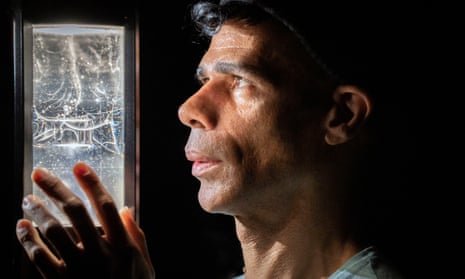An ampoule of Antarctic air from the year 1765 forms the centrepiece of a new exhibition that reveals the hidden histories contained in polar ice to visitors attending the Cop26 climate conference in Glasgow.
The artist Wayne Binitie has spent the past five years undertaking an extraordinary collaboration with scientists of the British Antarctic Survey (BAS), who drill, analyse and preserve cylinders of ice from deep in the ice sheet that record past climate change.
These ice cores have allowed Binitie to display in Glasgow, at what is widely acknowledged to be a pivotal moment for the planet, the purest possible air trapped in ice from another such moment, just before modern humanity began its unwitting destruction of the atmosphere, the stark consequences of which are now being faced.
The Polar Zero exhibition at the Glasgow Science Centre features a cylindrical glass sculpture encasing the air, extracted precisely from 1765 – the date that many historians pinpoint as the beginning of the Industrial Revolution. A second cylinder presents an ice core containing tiny bubbles of air that were trapped as snow fell and compacted, and which now reveal the horrifying rate of increase in atmospheric carbon dioxide since that date.
“The scale of the topic is so overwhelming and so complex that it can feel distant, even apocalyptic,” says Binitie, an Arts and Humanities Research Council-funded PhD student at the Royal College of Art. “People need something tangible to get hold of, that collapses that distance.”
The glaciologist Dr Robert Mulvaney, who was responsible for mining the ice for the BAS, says it is indeed possible to drill out ice from a particular era. “Snow falls in Antarctica year by year – but there’s no melting going on. So the snow builds up and compresses all the years of snow beneath. As we drill down we’re driving further and further into the past – a bit like counting the rings of a big tree.
“What helps is that every so often we know that a certain volcano blew up in a particular year and we may find evidence of that. So using our drills to find a specific year isn’t quite as hard as you would imagine.”
Putting together an exhibit based around an ampoule of air and a melting ice core proved a fascinating technical challenge, says Graham Dodd of the global engineering specialists Arup. “Exhibiting an ice core without it melting completely is a technical feat that requires precise calculations and creative thinking to construct the right level of insulation while still allowing the visitors to get up close to the ice.”
Visitors to Polar Zero will hear the ancient air bubbles popping as the ice core emerges from its insulated tube, blending with Binitie’s immersive soundtrack of music and natural sounds, and can touch and even taste the iced water. It’s a multisensory experience at a time when it “seems more urgent than ever before to ask what it means to touch and be in touch with the Earth”, he says.
